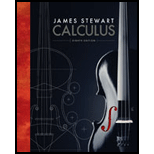
(a)
To write:
An integral expression for moment of inertia
Solution:
Explanation:
1) Concept:
The moment of inertia of a particle of mass m about an axis is defined to be
2) Calculations:
The given body about which the moment of inertia needs to be found is a thin sheet in the shape of a surface
And density function is
Therefore, the mass of each element is
And we have to find the moment of inertia about
The distance of each element from the
Therefore,
Moment of inertia of each element about
The moment of inertia of total sheet about
Conclusion:
An integral expression for moment of inertia
(b)
To find:
The moment of inertia about
Solution:
Explanation:
1) Concept:
Use the formula:
Where
2) Given:
Density
3) Calculations:
The given equation of cone is
Therefore,
The vector equation of surface
Differentiating with respect to
Then,
Therefore,
From concept,
The moment of inertia about
But
Therefore, above integral becomes,
Since,
Using polar coordinates,
The above integral becomes,
By integrating with respect to
By applying the limits of integration,
By simplifying,
Integrating with respect to
By applying the limits of integration,
Thus,
Conclusion:
The moment of inertia about
Want to see the full answer?
Check out a sample textbook solution
Chapter 16 Solutions
Calculus (MindTap Course List)
- 2. Symmetry Evaluate the following integrals using symmetry argu- ments. Let R = {(x, y): -a ≤ x ≤ a, −b ≤ y ≤ b}, where a and b are positive real numbers. a. SS Sf xye xye¯(x² + y²) dA R b. C sin (x − y) - dA x² + y² + 1 Rarrow_forwardChoose a convenient order When converted to an iterated integral, the following double integrals are easier to evaluate in one order please show all stepsarrow_forwardplease show all workarrow_forward
- calc 3arrow_forward3. P 2. 1 -3-2-10 1 2 3 -2- X The graph of point P is given in the xy-plane. Which of the following are possible polar coordinates of point P? A Ⓐ(2, 2) (2, 1/1/1) B (2, 3) C Ⓒ =) (2√2, 41 ) D (2√2, 3) 4arrow_forwardThe graph of f' is below. Use it to determine where the local minima and maxima for f are. If there are multiple answers, separate with commas. 2 f'(x) N -5 -4 3-2-1 -1 -2 -3 -4 12 3 4 5 -x Local minima at x Local maxima at xarrow_forward
- The graph of f' is below. Use it to determine the intervals where f is increasing. -5-4-32 4- 3 2 1 -2 -3 +x 2 3 4 5arrow_forwardThe graph of f' is below. Use it to determine where the inflection points are and the intervals where f is concave up and concave down. If there are multiple inflection points, separate with a comma. 6 5 4 3 2 1 f'(x) +x -6-5-4-3 -2 -1 1 2 3 4 5 6 -1 -2 -3 -4 -5 -6+ Inflection point(s) at x = Concave up: Concave down:arrow_forwardThe graph of f' is below. Use it to determine where the local minima and maxima for f are. If there are multiple answers, separate with commas. f'(x) 4- -5-4-3-8-1 3 2 1 x 1 2 3 4 5 -1 -2 -3 -4 Local minima at a Local maxima at =arrow_forward
 Calculus: Early TranscendentalsCalculusISBN:9781285741550Author:James StewartPublisher:Cengage Learning
Calculus: Early TranscendentalsCalculusISBN:9781285741550Author:James StewartPublisher:Cengage Learning Thomas' Calculus (14th Edition)CalculusISBN:9780134438986Author:Joel R. Hass, Christopher E. Heil, Maurice D. WeirPublisher:PEARSON
Thomas' Calculus (14th Edition)CalculusISBN:9780134438986Author:Joel R. Hass, Christopher E. Heil, Maurice D. WeirPublisher:PEARSON Calculus: Early Transcendentals (3rd Edition)CalculusISBN:9780134763644Author:William L. Briggs, Lyle Cochran, Bernard Gillett, Eric SchulzPublisher:PEARSON
Calculus: Early Transcendentals (3rd Edition)CalculusISBN:9780134763644Author:William L. Briggs, Lyle Cochran, Bernard Gillett, Eric SchulzPublisher:PEARSON Calculus: Early TranscendentalsCalculusISBN:9781319050740Author:Jon Rogawski, Colin Adams, Robert FranzosaPublisher:W. H. Freeman
Calculus: Early TranscendentalsCalculusISBN:9781319050740Author:Jon Rogawski, Colin Adams, Robert FranzosaPublisher:W. H. Freeman
 Calculus: Early Transcendental FunctionsCalculusISBN:9781337552516Author:Ron Larson, Bruce H. EdwardsPublisher:Cengage Learning
Calculus: Early Transcendental FunctionsCalculusISBN:9781337552516Author:Ron Larson, Bruce H. EdwardsPublisher:Cengage Learning





